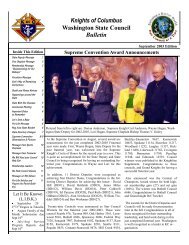WSC History - Knights of Columbus Washington State Council
WSC History - Knights of Columbus Washington State Council
WSC History - Knights of Columbus Washington State Council
You also want an ePaper? Increase the reach of your titles
YUMPU automatically turns print PDFs into web optimized ePapers that Google loves.
THE ORIGIN OF THE ORDERThe story <strong>of</strong> the origin <strong>of</strong> the Order is known in a general way by all <strong>Knights</strong> <strong>of</strong> <strong>Columbus</strong>. Theprincipal facts concerning the founding <strong>of</strong> the Order are contained in many pamphlets, books and otheraccounts.Members have heard parts <strong>of</strong> the story at their initiation and occasionally at banquets.Considering the vagaries <strong>of</strong> human memory, especially the flurry <strong>of</strong> events, facts and impressions at one's3rd Degree, it might be well to review again the early days <strong>of</strong> the Order. This would be for the benefit <strong>of</strong>those entering the Order in increasing numbers; for the benefit <strong>of</strong> those whose memory might be hazyand for the information <strong>of</strong> those outside the Order who might be interested.Father Michael J. McGivney is revered as the founder <strong>of</strong> the <strong>Knights</strong> <strong>of</strong> <strong>Columbus</strong>. As a youngpriest attached as a curate to St. Mary's Church in New Haven, Connecticut he displayed outstandingabilities. His pastor saw in him great promise as a man who would do great things for his Church. Hewas also respected by the parishioners. No one thought, at the time, that his influence would extend faroutside his own parish or diocese. They could not foresee that his name and influence would becomeknown in every parish and diocese in this country and several foreign countries as well.It is clear that Father McGivney was deeply concerned about the conditions <strong>of</strong> the Irishimmigrants who formed a large part <strong>of</strong> his parish. They had cometo the New England states to find the opportunities not available tothem in Ireland. Most were uneducated and could take only menialjobs. Those who were long established in the area, some withroots back to the Pilgrims and reared in the traditions <strong>of</strong>Puritanism, looked upon the Irish as a lower class people, withoutculture or background and capable <strong>of</strong> doing only rough manuallabor. This resulted in discrimination against the Irish and FatherMcGivney was determined to do something about it. He sought toinstitute an organization on behalf <strong>of</strong> the Irish. This accounts forthe fact that, in the beginning, almost all <strong>of</strong> the <strong>Knights</strong> <strong>of</strong><strong>Columbus</strong> were <strong>of</strong> Irish descent.Father McGivney <strong>of</strong>ten spoke to his people informally,talking with them about their economic and social problems andtrying to improve these conditions. As a result <strong>of</strong> all <strong>of</strong> this, it isrecorded that on the evening <strong>of</strong> January 16, 1882 a number <strong>of</strong> theprincipal parishioners met at St. Mary's to organize some means bywhich the religious, social and economic welfare <strong>of</strong> the parishioners could be improved. Among thoseattending were James T. McMullen, Daniel Colwell, John Tracy, Michael Tracy, William M. Geary,Cornelius T. Driscoll, John T. Kerrigan, James T. Mahon and William H. Sellwood. These men <strong>of</strong> faithand action became closely identified with the work <strong>of</strong> Father McGivney and some <strong>of</strong> them figureprominently in the early history <strong>of</strong> the Order. Indeed, James T. McMullen was the first Supreme Knight.At this meeting various past and existing organizations that might be suitable for their purposeswere investigated. It was decided to propose that the Irish form a Sodality <strong>of</strong> St. Mary's parish. FatherMcGivney presented his plan to Bishop Lawrence T. McMahon, also Irish, who rejected it completely.Father McGivney was not to be deterred so additional meetings were held. During these meetings it wasrecalled that there had been a Catholic society, the Sarsfield Guards - a part <strong>of</strong> the Connecticut NationalGuard consisting entirely <strong>of</strong> Catholic men. Bigots in the state prevailed upon the governor to disband theorganization. Other groups were investigated and found to be unsatisfactory. The most promising <strong>of</strong>these was the Massachusetts Catholic Order <strong>of</strong> Foresters. Father McGivney made a trip to Boston toinvestigate the feasibility <strong>of</strong> instituting a branch <strong>of</strong> this successful Order in New Haven. He had to reportback that, while the Order was eager to help, the Catholic Order <strong>of</strong> Foresters did not want a branchoutside <strong>of</strong> their own state.







